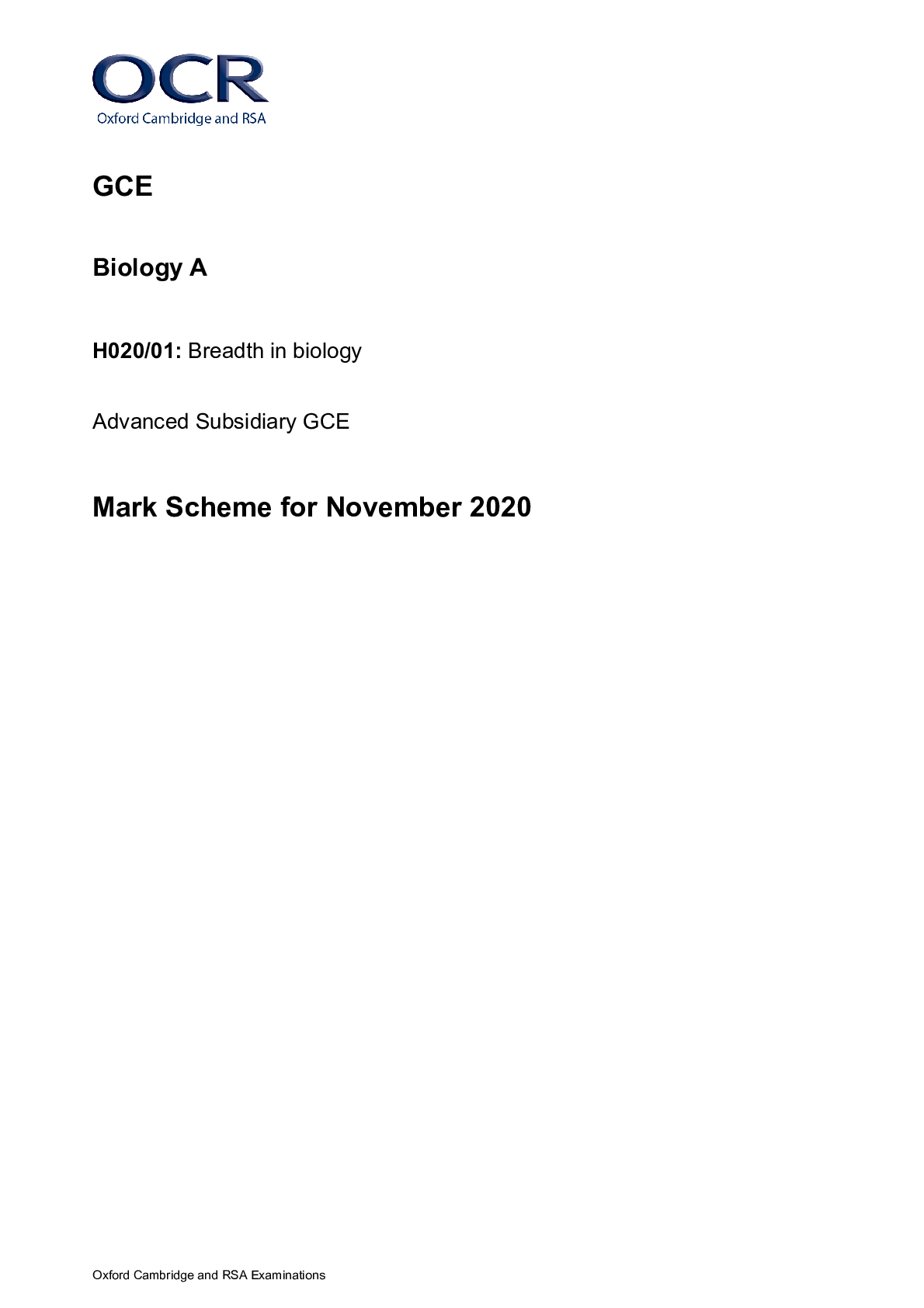Biology > GCSE MARK SCHEME > GCE Biology A H020/02: Depth in biology Advanced Subsidiary GCE Mark Scheme for November 2020 (All)
GCE Biology A H020/02: Depth in biology Advanced Subsidiary GCE Mark Scheme for November 2020
Document Content and Description Below
GCE Biology A H020/02: Depth in biology Advanced Subsidiary GCE Mark Scheme for November 2020 Oxford Cambridge and RSA Examinations GCE Biology A H020/02: Depth in biology Advanced Subsidiary GCE... Mark Scheme for November 2020Oxford Cambridge and RSA Examinations OCR (Oxford Cambridge and RSA) is a leading UK awarding body, providing a wide range of qualifications to meet the needs of candidates of all ages and abilities. OCR qualifications include AS/A Levels, Diplomas, GCSEs, Cambridge Nationals, Cambridge Technicals, Functional Skills, Key Skills, Entry Level qualifications, NVQs and vocational qualifications in areas such as IT, business, languages, teaching/training, administration and secretarial skills. It is also responsible for developing new specifications to meet national requirements and the needs of students and teachers. OCR is a not-for-profit organisation; any surplus made is invested back into the establishment to help towards the development of qualifications and support, which keep pace with the changing needs of today’s society. This mark scheme is published as an aid to teachers and students, to indicate the requirements of the examination. It shows the basis on which marks were awarded by examiners. It does not indicate the details of the discussions which took place at an examiners’ meeting before marking commenced. All examiners are instructed that alternative correct answers and unexpected approaches in candidates’ scripts must be given marks that fairly reflect the relevant knowledge and skills demonstrated. Mark schemes should be read in conjunction with the published question papers and the report on the examination. © OCR 2020H420/02 Mark Scheme November 2020 Annotations Annotation Meaning DO NOT ALLOW Answers which are not worthy of credit IGNORE Statements which are irrelevant ALLOW Answers that can be accepted ( ) Words which are not essential to gain credit __ Underlined words must be present in answer to score a mark ECF Error carried forward AW Alternative wording ORA Or reverse argumentH420/02 Mark Scheme November 2020H020/02 Mark Scheme November 2020 4 Subject-specific Marking Instructions INTRODUCTION Your first task as an Examiner is to become thoroughly familiar with the material on which the examination depends. This material includes: • the specification, especially the assessment objectives • the question paper • the mark scheme. You should ensure that you have copies of these materials. You should ensure also that you are familiar with the administrative procedures related to the marking process. These are set out in the OCR booklet Instructions for Examiners. If you are examining for the first time, please read carefully Appendix 5 Introduction to Script Marking: Notes for New Examiners. Please ask for help or guidance whenever you need it. Your first point of contact is your Team Leader.H420/02 Mark Scheme November 2020 5 Question AO Answer Mark Guidance 1 (a) (i) 2.3 3.4 label ribosome ✓ explanation cannot see with, this / light, microscope / need EM to see ✓ (LM) resolution, not high enough / too low ✓ (LM) magnification, not high enough / too low ✓ it is a nucleus ✓ OR label (large permanent) vacuole ✓ explanation it is an air bubble ✓ it spans more than one cell ✓ a vacuole is inside one cell ✓ 3 max 1 mark for identifying incorrect label. 2 max for matching explanation. IGNORE structure shown too large ALLOW not visible / cannot be, viewed / detected for ‘see’ ALLOW resolution not, sharp / clear / strong / detailed, enough 1 (a) (ii) 3.4 any three from: label lines should not cross ✓ no arrowheads ✓ no, shading / colouring in ✓ give, magnification / scale ✓ give title ✓ draw cell walls as two lines ✓ draw organelles in proportion ✓ 3 max ALLOW must be parallel ALLOW give diagram a name ALLOW ref. nuclei /structures labelled as ribosomes, too bigH420/02 Mark Scheme November 2020 6 1 (b) 1.1 TEM has, better / higher, resolution ✓ TEM (resolution figure in range) 0.05 - 2 nm ✓ (shows) image of cell interior ✓ (shows) ultrastructure / (two named) cell organelles ✓ SEM (resolution figure in range) 5 - 50 nm ✓ (shows) 3D / three-dimensional, image ✓ (shows cell) surface / topography ✓ 4 max ALLOW ora SEM has, worse / lower resolution IGNORE magnification ALLOW 0.00005 - 0.002 µm / 50 – 2000 pm ‘TEM has resolution of 0.5nm whereas SEM only has resolution of 3-10nm’ gets mps 1, 2, 5 (as comparative implied by ‘only’) ALLOW 0.005 – 0.05 µm ALLOW see depth DO NOT ALLOW organelles in cell unless fracture explained 1 (c) (i) 2.1 E1 (erythrocytes / neutrophils, formed in the) spleen C1 (formed in) bone marrow ✓ E2 (ciliated epithelial cells in) blood vessels C2 in, trachea / bronchi / bronchioles / airways / lungs / respiratory system / oviducts / central canal of spinal cord ✓ E3 cell wall thickest (on side furthest from stoma) C3 cell wall thin(ner) (on side furthest from stoma) ✓ 3 E1 ALLOW erythrocytes / neutrophils (formed in the spleen) C1 ALLOW lymphocytes (are formed in spleen) E2 ALLOW ciliated (epithelial cells in blood vessels) C2 ALLOW squamous (epithelial / endothelial, cells in blood vessels) DO NOT ALLOW digestive system / ileum E3 ALLOW (cell wall thickest) on side furthest from stoma C3 ALLOW (cell wall thick(er)) on, inner side / side nearest stoma 1 (c) (ii) 2.6 FIRST CHECK ANSWER ON ANSWER LINE correct answer = 2 marks 35.7 ✓ ✓ 1 mark for working if final answer wrong: (normal production = 1.6 x 73 x 24) = 2803.2 / 2803 ✓ or (difference = 3804 – 2803.2) = 1000.8 / 1001 ✓ 2 ALLOW figure in range 35.4 – 36 with up to 3 dp correct for working shown ALLOW (hospital production rate = 3804 ÷ (73 x 24)) = 2.17 or ALLOW (difference in rate = 2.17 – 1.6) = 0.57H420/02 Mark Scheme November 2020 7 1 (c) (iii) 1.1 For answers marked by levels of response: Read through the whole answer from start to finish, concentrating on features that make it a stronger or weaker answer using the indicative scientific content as guidance. The indicative scientific content indicates the expected parameters for candidates’ answers, but be prepared to recognise and credit unexpected approaches where they show relevance. Using a ‘best-fit’ approach based on the science content of the answer, first decide which set of level descriptors, Level 1, Level 2 or Level 3, best describes the overall quality of the answer using the guidelines described in the level descriptors in the mark scheme. Once the level is located, award the higher or lower mark. The higher mark should be awarded where the level descriptor has been evidenced and all aspects of the communication statement (in italics) have been met. The lower mark should be awarded where the level descriptor has been evidenced but aspects of the communication statement (in italics) are missing. In summary: • The science content determines the level. • The communication statement determines the mark within a level. Level 3 (5–6 marks) Full and detailed description of how each cell’s specialised structure is suited to function: erythrocytes, neutrophils, squamous (epithelial) cells and ciliated (epithelial) cells. Candidate demonstrates a good understanding of the specialised features in all of these cells, and how these features make the cells suited to their specific function. There is a well-developed line of reasoning, which is clear and logically-structured and uses scientific terminology at an appropriate level. All the information presented is relevant and forms a continuous narrative. Level 2 (3–4 marks) A correct feature for each type of cell stated and linked to function of cell. There is a line of reasoning presented with some structure and use of appropriate scientific language. The information presented is mostly relevant. 6 max Indicative scientific points may include the following: erythrocyte / red blood cell biconcave / flattened, disc no nucleus contain haemoglobin flexible shape 7.5 µm diameter 2.0 µm thick ref. contain carbonic anhydrase transport oxygen transport carbon dioxide move / squeeze, through, blood vessels / capillaries space for, oxygen / haemoglobin, maximised large surface area to volume ratio short diffusion distance to, centre of cell / all haemoglobin neutrophil / white blood cell granular cytoplasm many lysosomes hydrolytic / digestive, enzymes multilobed nucleusH420/02 Mark Scheme November 2020 8 Level 1 (1–2 marks) Some features correctly linked to a cell type. The linking of structure to function in outline only. The information is communicated with only a little structure. Communication is hampered by the inappropriate use of technical terms. 0 marks No response or no response worthy of credit. can change shape / diapedesis / phagocytosis 10-14 µm diameter immune response innate / non-specific / inflammation destroy / engulf, (named) pathogens / bacteria move to site of infection / wound squamous (epithelial cells) flattened shape very thin / (form layer) one cell thick fit together, tightly / like a pavement for rapid diffusion / short diffusion distance of, oxygen / carbon dioxide / gases, at alveoli / lungs / blood vessels ciliated (epithelial cells) have cilia / ‘hair like’ structures which, move / beat in rhythm to move mucus and trapped, pathogens / dust / debris from, lungs / (named) airways to move, ovum / egg from ovary / to uterus / to site of fertilisation to move cerebrospinal fluid / ventricular fluidH420/02 Mark Scheme November 2020 9 Question AO Answer Mark Guidance 2 (a) (i) 2.1 to provide, lots of / much, energy / ATP ✓ 1 DO NOT ALLOW make / produce energy. ALLOW cell, needs / uses, lots of, energy / ATP 2 (a) (ii) 2.1 Golgi apparatus ✓ to, modify / process / package, protein ✓ ref. vesicles / secretion (of mucus) / exocytosis ✓ 2 max ALLOW smooth endoplasmic reticulum / SER ALLOW lipid / triglyceride, synthesis (for smooth ER) 2 (b) (i) 2.4 FIRST CHECK ANSWER ON ANSWER LINE correct answer = 2 marks 1,000,000 / 1 x 106 ✓ ✓ 1 mark for working if final answer wrong: 40 x 500 = (20, 000cm3) ✓ or 20 ms is 20/1000 = 0.02 s ✓ 2 ALLOW calculation combined with wrong time figure e.g. 40 x 500 x 3 = 60, 000 ALLOW (1s ÷ 0.02 s / 1000 ms ÷ 20 ms) = 50 2 (b) (ii) 2.1 (more) infections / irritation / coughing ✓ 1 ALLOW bronchitis / pneumonia / bacterial disease / viral disease 2 (c) (i) 2.1 line joins C to N and C=O drawn in (any side or angle) and N-H (any side or angle) ✓ peptide (bond) ✓ 2 DO NOT ALLOW dipeptide / pepticH420/02 Mark Scheme November 2020 10 2 (c) (ii) 1.1 reaction between / joins, (carboxylic) acid and alcohol ✓ reaction between / joins, fatty acid(s) and glycerol ✓ condensation reaction / removal of water (molecule) ✓ 2 max 2 (d) (i) 2.4 FIRST CHECK ANSWER ON ANSWER LINE correct answer = 2 marks 0.00346 x 109 / 3.46 x 106 / 3, 460, 209 ✓ ✓ 1 mark for working stages or intermediate answer if final answer wrong: calculate 1.11% of 2018 population 7.7 x 109 x 1.11 ÷ 100 = 0.08547 x 109 ✓ or calculate 2019 population by adding 1.11% figure to original population 7.7 x 109 + 0.08547 x 109 = 7.78547 x 109 / 7, 785, 470, 000 ✓ or calculate photosensitive lupus sufferers by dividing 2019 population figure by 1350 and finding 60% of this: (7.78547 x 109 ÷ 1350) = 0.00577 x 109 / 5, 767, 014 (5, 767, 014 x 60 ÷ 100) = 3, 460, 208.8 / 3, 460, 208 ✓ 2 ALLOW rounding to 3.5 x 106 ALLOW first two steps combined: 7.7 x 109 x 101.11 ÷ 100 = 7.78547 x 109 (or 7.7 x 109 x 1.0111) ALLOW find 0.074% i.e. x 0.074 ÷ 100 instead of dividing by 1350 2 (d) (ii) 2.1 ultraviolet / UV (light / rays / radiation / photons) AND skin rash ✓ 1 2 (d) (iii) 1.2 2.5 idea that immune system, attacks / damages, own / self, cells / tissue / antigens ✓ plus any one of: genetic / passed down in genes / linked to certain alleles / ref. DNA ✓ 2 ALLOW own cells, attacked / treated, as, foreign / nonself, by immune system / immune cells / antibodies DO NOT ALLOW attacks own, bacteria / molecules IGNORE hereditary / inheritedH420/02 Mark Scheme November 2020 11 Question AO Answer Mark Guidance 3 (a) 1.1 Pathogen Communicable Disease bacterium tuberculosis (TB) prot(oct)ist(a) ✓ potato late blight prot(oct)ist(a) ✓ malaria 2 ALLOW fungus / fungi for potato late blight IGNORE Phytophthora IGNORE Plasmodium 3 (b) (i) 2.8 FIRST CHECK ANSWER ON ANSWER LINE correct answer = 2 marks 21 ✓ ✓ 1 mark for working stage or intermediate answer if final answer wrong: (175 x 17 ÷ 100 or 175 x 0.17) = 29.75 / 30 ✓ or (29.75 x 70 ÷ 100 or 29.75 x 0.7) = 20.825 ✓ 2 ALLOW 29 or 30 for 29.75 in second working step 3 (b) (ii) 3.3 sample size relatively small / only 175 children tested ✓ ages of children varied ✓ difficulties in interpreting the response of the dog ✓ socks could be different (in fabric) ✓ socks could have been, worn for different lengths of time / shared ✓ ref. different, soaps / washing powders, used (on feet / socks) ✓ 1 max ALLOW different, soaps / washing powders, have different smells 3 (c) (i) 1.2 clump / aggregate / join, pathogens ✓ stops pathogens, moving / reproducing ✓ (helps) phagocytes then engulf (multiple / clumped) pathogens / phagocytosis of (clumped) pathogens ✓ 2 maxH420/02 Mark Scheme November 2020 12 Question AO Answer Mark Guidance 4 (a) 3.1 3.2 1 data (as a whole) do not show, direct / positive / indirect / negative / any, correlation ✓ 2 direct / positive, correlation is opposite to, conclusion / trend, student describes ✓ 3 rest home time trend supports negative correlation / as % vaccination decreases number of flu cases increases in rest homes / when vaccination higher flu cases lower ✓ 4 schools trend supports positive correlation / as % vaccination decreases number of flu cases decreases in schools / when vaccination higher flu cases higher ✓ 5 hospitals / other, trends show no correlation / as % vaccination decreases number of flu cases may increase or decrease or stay the same ✓ 6 idea that need to plot % vaccination against number of flu cases to judge correlation / uptake and cases highest in rest homes ✓ 7 compare figures from 2 years for one group OR from 2 groups for one year OR rest homes and other both at 70% uptake ✓ 8 limitation of data ✓ 4 max max 3 if do not state mp1 ALLOW ora conclusion / trend, student describes is, indirect / negative correlation ALLOW ‘flu case figures + / – 20 for mp 7 Percentage uptake of vaccine 2015-16 2016-17 2017-18 rest homes 77 75 70 hospitals 57 60 59 schools 42 36 38 other 70 67 50 8 only three years studied / small sample sizes / not a comparison of standardised groups / case numbers not per 100, 000 / percentages / age / gender / other health problems, not controlled Number of ‘flu cases 2015-16 2016-17 2017-18 rest homes 240 890 1690 hospitals 120 170 240 schools 280 60 170 other 40 20 60H420/02 Mark Scheme November 2020 13 4 (b) 1.2 any three matched to steps in correct order: step 3 antigen presentation / antigen binds to specific, B / T, lymphocyte / cell ✓ steps 3 or 4 clonal selection / clonal expansion / plasma cells produced / produce antibodies primary immune response ✓ step 5 ref. memory cells / secondary immune response ✓ 3 ALLOW two steps in correct order in any two step spaces if one step space left blank (e.g. if whole sequence written as 3 and 4 with no 5) 4 (c) 2.6 herd immunity ✓ fewer people can, catch / spread, virus / measles OR vaccinated individuals / most people, cannot catch / spread, virus / measles ✓ R(0) number reduced ✓ 2 max ALLOW less / slower / decreases, transmission / spreadH420/02 Mark Scheme November 2020 14 Question AO Answer Mark Guidance 5 (a) (i) 3.4 repeats and calculate mean (at each temperature) ✓ use a biosensor (to measure glucose concentration) (test at) more / smaller, temperature intervals (test at) more / smaller / shorter, time intervals 1 max IGNORE different temperatures 5 (a) (ii) 3.4 concentration of glucose (solution in bag / tubing) ✓ volume of the glucose solution (in bag / tubing) ✓ volume of (distilled) water (in beaker) ✓ volume of sample, removed / tested ✓ volume of Benedict’s reagent used ✓ length of, Visking tubing / artificial cell ✓ time in water bath for Benedict’s test ✓ 1 max IGNORE amount for volume throughout ALLOW surface area to volume ratio of Visking tubing 5 (b) (i) 3.4 hypothesis: as temperature increases, movement of glucose into the (distilled) water / concentration of glucose (in samples), increases ✓ scientific process: diffusion ✓ 2 IGNORE null hypothesis ALLOW as temperature increases diffusion rate increases ALLOW particles, move faster / have more kinetic energy 5 (b) (ii) 3.1 3.2 as temperature increases, more glucose is found in the water / diffusion rate is faster ✓ result for 60 seconds at 20oC, anomalous / does not support ✓ 2 ECF from wrong hypothesis in 5 (b)(i). ALLOW 1 max for no when supported with a reference to the anomaly at 60 seconds at 20oC 5 (c) 3.4 use one / control, temperature ✓ use two / more, layers of, Visking / dialysis, tubing ✓ 2 CREDIT keep temperature, the same / constant IGNORE make Visking tubing thicker ALLOW fold / layer, Visking tubingH420/02 Mark Scheme November 2020 15 Question AO Answer Mark Guidance 6 (a) 2.2 3.1 surface area to volume ratio = 3 : 1 (small) and 1.5 : 1 (large) or large, cube / animal, has smaller SA:vol or small, cube / animal, has larger SA:vol ✓ diffusion, distance / pathway, long / deep, in large, cube / animal or diffusion time long in large, cube / animal ✓ relatively / proportionally, small(er) surface cannot supply large(r) volume of cells ✓ specialised exchange surfaces needed for, oxygen / carbon dioxide / gases / nutrients / waste products ✓ 2 max ALLOW SA : volume or SA : V for surface area to volume ratio ALLOW 3 : 2 for 1.5 : 1 DO NOT ALLOW reverse ratios 1 : 3 and 1 : 1.5 (unless volume : SA stated) IGNORE diffusion, easier / harder ALLOW ora diffusion, distance / pathway / time, shorter in small, cube / animal 6 (b) 2.1 2.3 For answers marked by levels of response: Read through the whole answer from start to finish, concentrating on features that make it a stronger or weaker answer using the indicative scientific content as guidance. The indicative scientific content indicates the expected parameters for candidates’ answers, but be prepared to recognise and credit unexpected approaches where they show relevance. Using a ‘best-fit’ approach based on the science content of the answer, first decide which set of level descriptors, Level 1, Level 2 or Level 3, best describes the overall quality of the answer using the guidelines described in the level descriptors in the mark scheme. Once the level is located, award the higher or lower mark. The higher mark should be awarded where the level descriptor has been evidenced and all aspects of the communication statement (in italics) have been met. The lower mark should be awarded where the level descriptor has been evidenced but aspects of the communication statement (in italics) are missing. In summary: • The science content determines the level. • The communication statement determines the mark within a level. Level 3 (5–6 marks) Full and detailed description of respiratory system in both fish and insect, showing how both are adapted to maximise ventilation and gaseous exchange. Reference made to structures shown on both Fig. 6.2 and Fig. 6.3 shown in the insert. 6 Indicative scientific points may include the following: bony fish ventilation water enters mouth ref. volume / pressure, change in buccal cavity water, flows / pushed, over gillsH420/02 Mark Scheme November 2020 16 There is a well-developed line of reasoning, which is clear and logically-structured and uses scientific terminology at an appropriate level. All the information presented is relevant and forms a continuous narrative. Level 2 (3–4 marks) Candidate demonstrates some understanding of the two exchange surfaces shown in Fig. 6.2 and Fig. 6.3 in the Insert. Not clearly linked to both ventilation and gas exchange. There is a line of reasoning presented with some structure and use of appropriate scientific language. The information presented is mostly relevant. Level 1 (1–2 marks) A description of some of the features of the respiratory systems of both fish and insect but not clearly linked to ventilation or gaseous exchange. Very few references to structures shown on Fig. 6.2 and Fig. 6.3 on the insert. The information is communicated with only a little structure. Communication is hampered by the inappropriate use of technical terms. 0 marks No response or no response worthy of credit. water leaves via operculum throughflow system / one direction of flow bony fish gas exchange gill, filaments / lamellae (shown on Fig. 6.2) large surface area thin short diffusion distance good blood supply / blood vessels (shown on Fig. 6.2) steep concentration gradient counter current system (water and blood move in opposite directions) tips of gill filaments overlap to slow down water movement insect ventilation muscular movement abdominal, dorso-ventral flattening / telescoping / pumping ref. volume / pressure, change in abdomen thorax, movement / shape change, in flight air drawn in or forced out size of spiracle, changes / controlled external gills in aquatic insects small size / large SA:vol of insects, means diffusion may be sufficient insect gas exchange gas / oxygen / CO2, diffuses along tracheae (shown on Fig. 6.3) oxygen dissolves in water at tracheoles diffuses into surrounding cells many tracheoles so large surface area spirals of chitin (shown on Fig. 6.3) hold tracheae open 6 (c) 1.1 cartilage stops, trachea / bronchus, from collapsing ✓ 2 ALLOW for support of trachea / bronchiH420/02 Mark Scheme November 2020 17 elastic fibres recoil of, alveoli / air sacs ✓OCR (Oxford Cambridge and RSA Examinations) The Triangle Building Shaftesbury Road Cambridge CB2 8EA OCR Customer Contact Centre Education and Learning Telephone: 01223 553998 Facsimile: 01223 552627 Email: general.qualifications@ocr.org.uk [Show More]
Last updated: 2 years ago
Preview 1 out of 19 pages

Buy this document to get the full access instantly
Instant Download Access after purchase
Buy NowInstant download
We Accept:

Reviews( 0 )
$6.00
Can't find what you want? Try our AI powered Search
Document information
Connected school, study & course
About the document
Uploaded On
Oct 07, 2022
Number of pages
19
Written in
Additional information
This document has been written for:
Uploaded
Oct 07, 2022
Downloads
0
Views
191

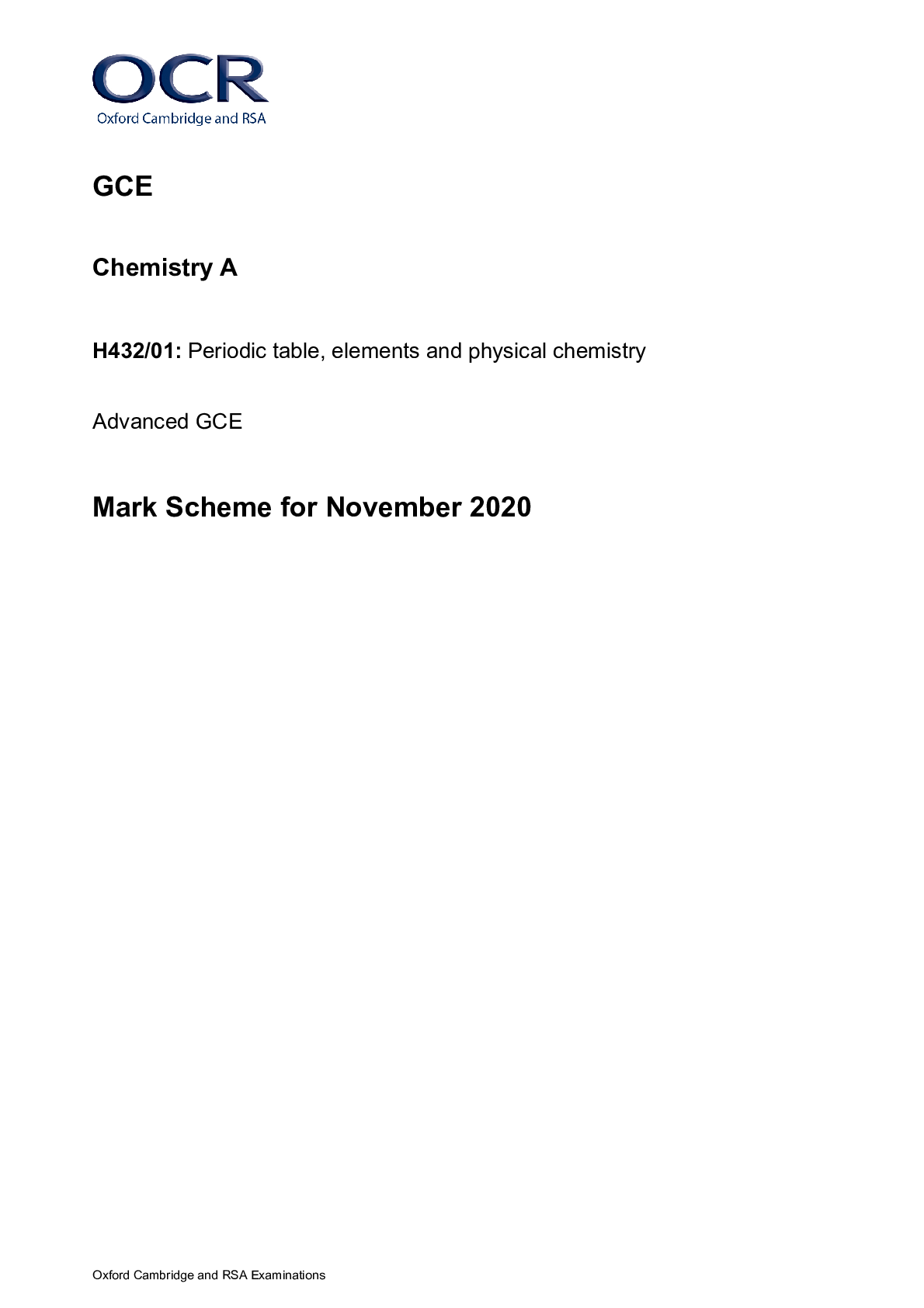


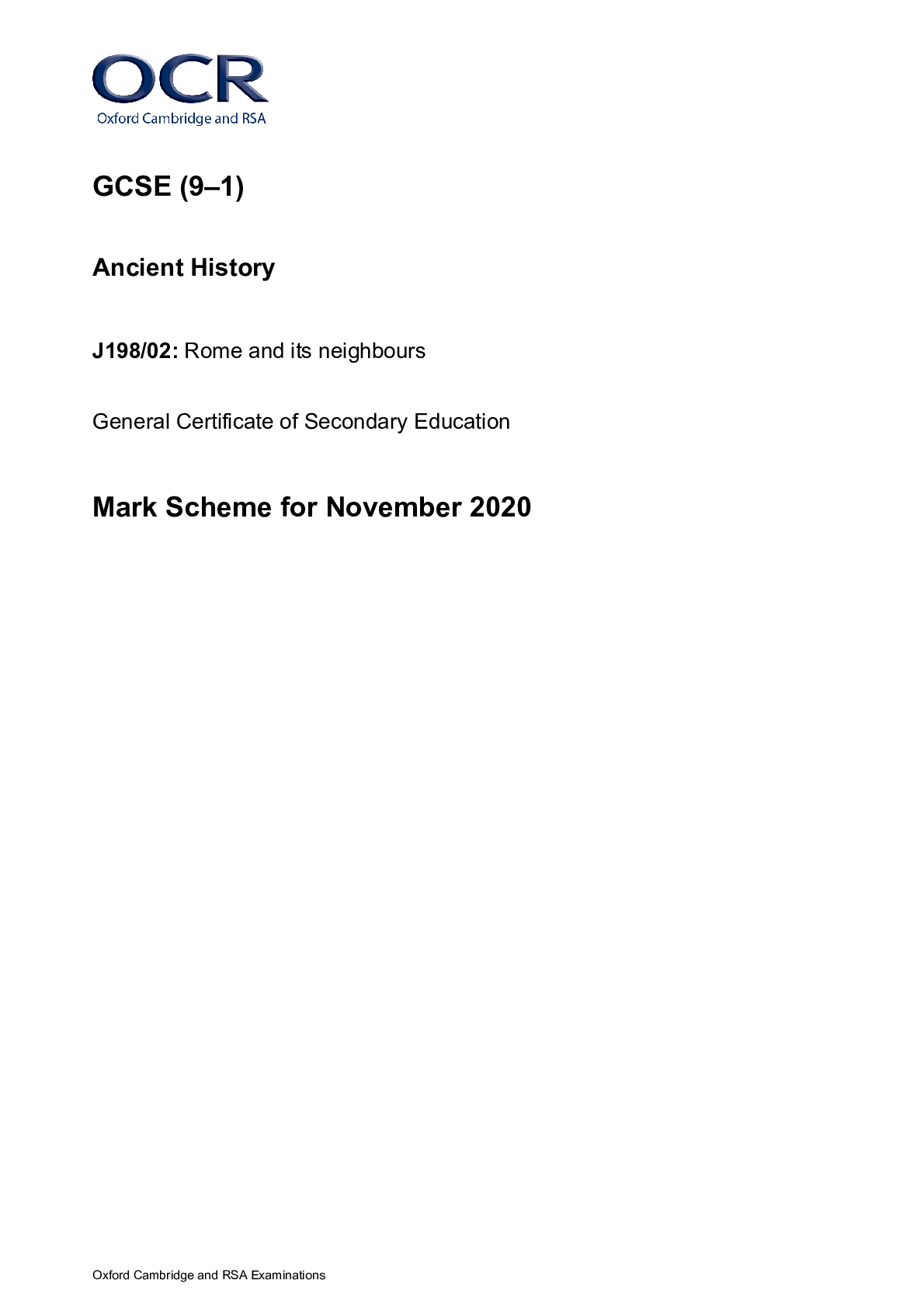




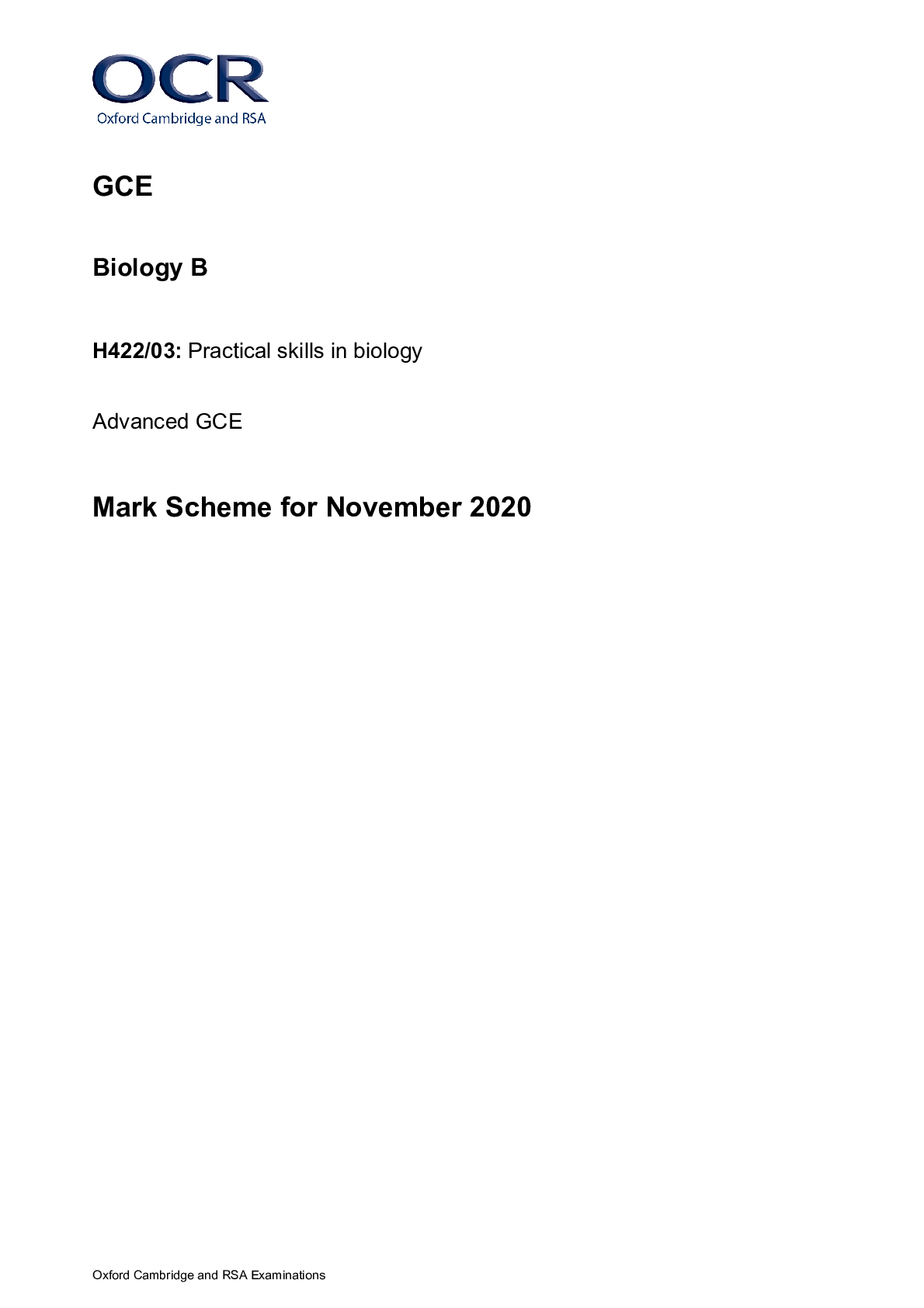
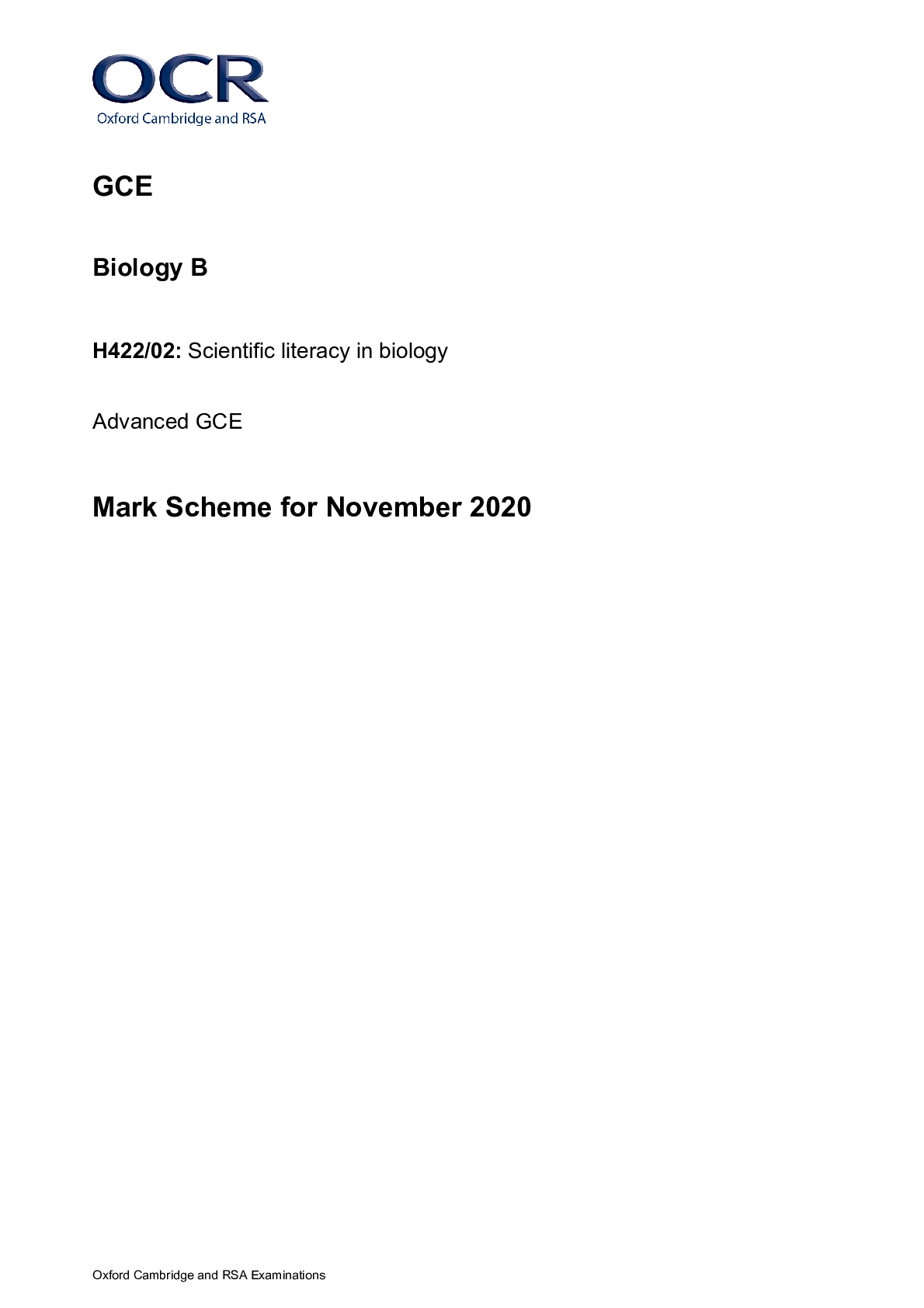
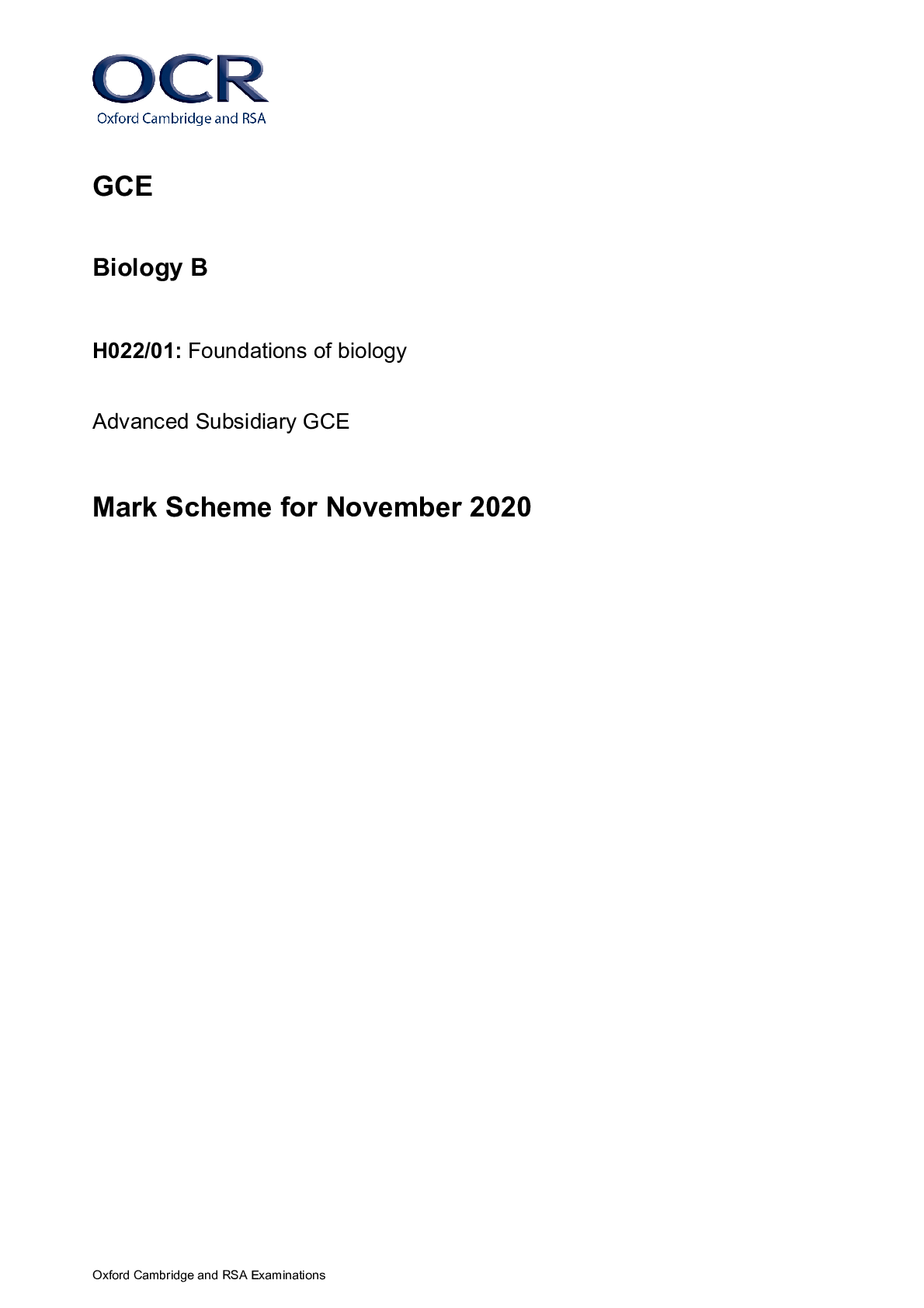



.png)
H630-02 Pure Mathematics and Statistics Advanced Subsidiary GCE Mark Scheme for Autumn 2021.png)



